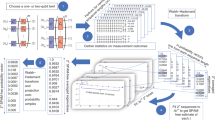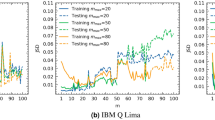Abstract
In theory, quantum computers offer a means of solving problems that would be intractable on conventional computers. Assuming that a quantum computer could be constructed, it would in practice be required to function with noisy devices called ‘gates’. These gates cause decoherence of the fragile quantum states that are central to the computer's operation. The goal of so-called ‘fault-tolerant quantum computing’ is therefore to compute accurately even when the error probability per gate (EPG) is high. Here we report a simple architecture for fault-tolerant quantum computing, providing evidence that accurate quantum computing is possible for EPGs as high as three per cent. Such EPGs have been experimentally demonstrated, but to avoid excessive resource overheads required by the necessary architecture, lower EPGs are needed. Assuming the availability of quantum resources comparable to the digital resources available in today's computers, we show that non-trivial quantum computations at EPGs of as high as one per cent could be implemented.
This is a preview of subscription content, access via your institution
Access options
Subscribe to this journal
Receive 51 print issues and online access
$199.00 per year
only $3.90 per issue
Buy this article
- Purchase on Springer Link
- Instant access to full article PDF
Prices may be subject to local taxes which are calculated during checkout




Similar content being viewed by others
References
Shor, P. W. Polynomial-time algorithms for prime factorization and discrete logarithms on a quantum computer. SIAM J. Comput. 26, 1484–1509 (1997)
Feynman, R. P. Simulating physics with computers. Int. J. Theor. Phys. 21, 467–488 (1982)
Abrams, D. S. & Williams, C. P. Fast quantum algorithms for numerical integrals and stochastic processes. Preprint at http://arXiv.org/quant-ph/9908083 (1999).
DiVincenzo, D. The physical implementation of quantum computation. Fort. Phys. 48, 771–783 (2000)
Preskill, J. Reliable quantum computers. Proc. R. Soc. Lond. A 454, 385–410 (1998)
Kitaev, A. Y. Quantum computations: Algorithms and error correction. Russ. Math. Surv. 52, 1191–1249 (1997)
Aharonov, D. & Ben-Or, M. Fault-tolerant quantum computation with constant error. Preprint at http://www.arXiv.org/quant-ph/9906129 (1999).
Knill, E., Laflamme, R. & Zurek, W. H. Resilient quantum computation. Science 279, 342–345 (1998)
Steane, A. M. Overhead and noise threshold of fault-tolerant quantum error correction. Phys. Rev. A 68, 042322 (2003)
Gottesman, D. Stabilizer Codes and Quantum Error Correction. PhD thesis, California Institute of Technology, Pasadena (1997)
Leibfried, D. et al. Experimental demonstration of a robust, high-fidelity geometric two ion-qubit phase gate. Nature 422, 412–415 (2003)
Roos, C. F. et al. Bell states of atoms with ultralong lifetimes and their tomographic state analysis. Phys. Rev. Lett. 220402 (2004)
Knill, E., Laflamme, R., Martinez, R. & Tseng, C.-H. An algorithmic benchmark for quantum information processing. Nature 404, 368–370 (2000)
Childs, A. M., Chuang, I. L. & Leung, D. W. Realization of quantum process tomography in NMR. Phys. Rev. A 64, 012314 (2001)
Nielsen, M. A. & Chuang, I. L. Quantum Computation and Quantum Information (Cambridge Univ. Press, Cambridge, UK, 2001)
Knill, E. Scalable quantum computation in the presence of large detected-error rates. Preprint at http://www.arXiv.org/quant-ph/0312190 (2003).
Gottesman, D. & Chuang, I. L. Demonstrating the viability of universal quantum computation using teleportation and single-qubit operations. Nature 402, 390–393 (1999)
Zhou, X., Leung, D. W. & Chuang, I. L. Methodology for quantum logic gate construction. Phys. Rev. A 62, 052316 (2000)
Bollinger, J. J., Heinzen, D. J., Itano, W. M., Gilbert, S. L. & Wineland, D. J. A 303 MHz frequency standard based on trapped Be+ ions. IEEE Trans. Instrum. Meas. 40, 126–128 (1991)
Steane, A. M. Quantum computer architecture for fast entropy extraction. Quant. Inf. Comput. 4, 297–306 (2002)
Svore, K. M., Terhal, B. M. & DiVincenzo, D. P. Local fault-tolerant quantum computation. Preprint at http://www.arXiv.org/quant-ph/0410047 (2004).
Steane, A. Space, time, parallelism and noise requirements for reliable quantum computing. Fort. Phys. 46, 443–457 (1998)
Knill, E. Fault-tolerant postselected quantum computation: Threshold analysis. Preprint at http://www.arXiv.org/quant-ph/0404104 (2004).
Knill, E. Quantum computing with very noisy devices. Preprint at http://www.arXiv.org/quant-ph/0410199 (2004).
Raussendorf, R. & Briegel, H. J. A one-way quantum computer. Phys. Rev. Lett. 86, 5188–5191 (2001)
Bennett, C. H. et al. Teleporting an unknown quantum state via dual classical and Einstein–Podolsky–Rosen channels. Phys. Rev. Lett. 70, 1895–1899 (1993)
Bennett, C. H. et al. Purification of noisy entanglement and faithful teleportation via noisy channels. Phys. Rev. Lett. 76, 722–725 (1996)
Shor, P. W. In Proc. 37th Symp. Foundations of Computer Science (FOCS) 56–65 (IEEE Press, Los Alamitos, California, 1996)
Knill, E., Laflamme, R. & Zurek, W. Resilient quantum computation: Error models and thresholds. Proc. R. Soc. Lond. A 454, 365–384 (1998)
Knil, E. Fault-tolerant postselected quantum computation: Schemes. Preprint at http://www.arXiv.org/quant-ph/0402171 (2004).
Bravyi, S. & Kitaev, A. Universal quantum computation based on a magic states distillation. Preprint at http://www.arXiv.org/quant-ph/0403025 (2004).
DiVincenzo, D. P., Shor, P. W. & Smolin, J. A. Quantum-channel capacity of very noisy channels. Phys. Rev. A 57, 830–839 (1998)
Intel Cooperation. Microprocessor quick reference guide. http://www.intel.com/pressroom/kits/quickreffam.htm (2004).
Reichardt, B. W. Improved ancilla preparation scheme increases fault tolerant threshold. Preprint at http://www.arXiv.org/quant-ph/0406025 (2004).
Acknowledgements
This work is a contribution of NIST, an agency of the US government, and is not subject to US copyright. Partial support from the DARPA QuIST programme is acknowledged.
Author information
Authors and Affiliations
Corresponding author
Ethics declarations
Competing interests
The author declares that he has no competing financial interests.
Supplementary information
Supplementary Methods
Contains Supplementary Figures 1 to 10 and references. (A) Graphical networks useful for implementing the architecture presented. (B) A discussion of how the architecture was simulated. (C) The details underlying the resource graph computations. (PDF 210 kb)
Rights and permissions
About this article
Cite this article
Knill, E. Quantum computing with realistically noisy devices. Nature 434, 39–44 (2005). https://doi.org/10.1038/nature03350
Received:
Accepted:
Issue Date:
DOI: https://doi.org/10.1038/nature03350
This article is cited by
-
Time-Efficient Constant-Space-Overhead Fault-Tolerant Quantum Computation
Nature Physics (2024)
-
Encoding a magic state with beyond break-even fidelity
Nature (2024)
-
Quantum image compression with autoencoders based on parameterized quantum circuits
Quantum Information Processing (2024)
-
Quantum networks with neutral atom processing nodes
npj Quantum Information (2023)
-
Resource-efficient fault-tolerant one-way quantum repeater with code concatenation
npj Quantum Information (2023)
Comments
By submitting a comment you agree to abide by our Terms and Community Guidelines. If you find something abusive or that does not comply with our terms or guidelines please flag it as inappropriate.



